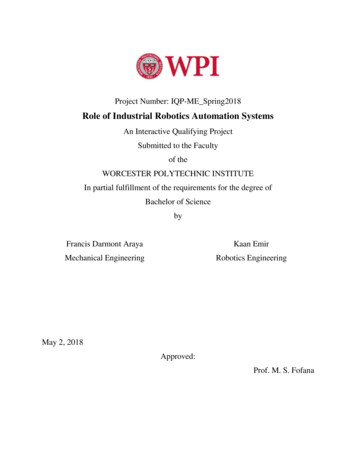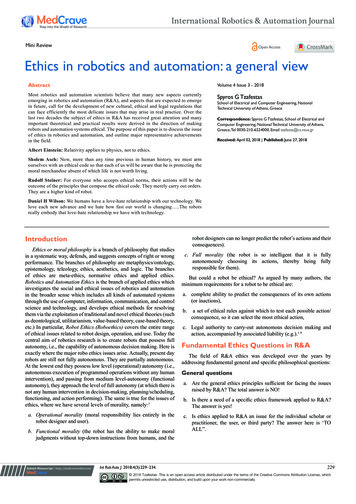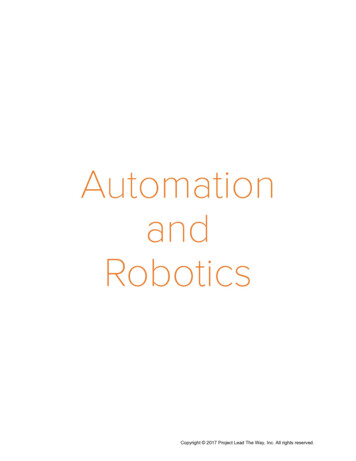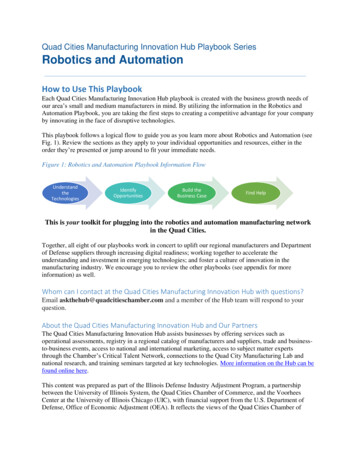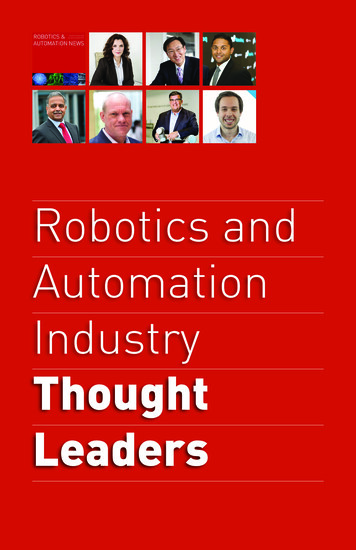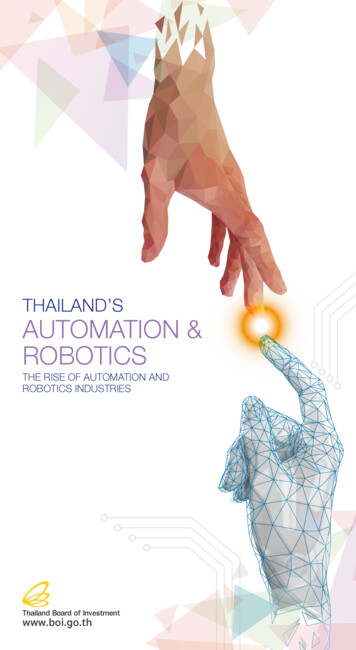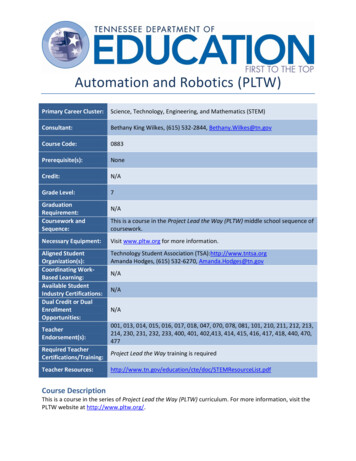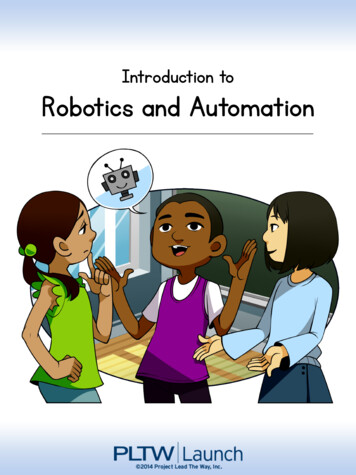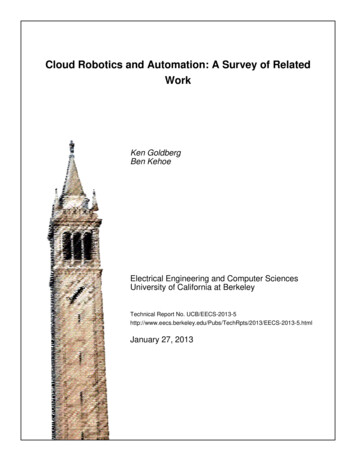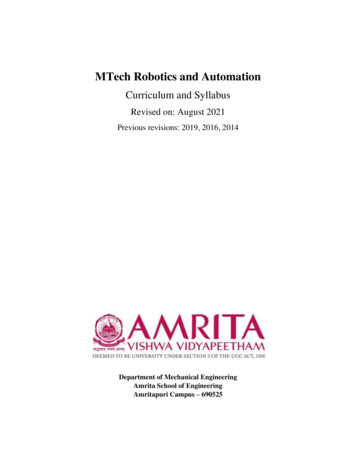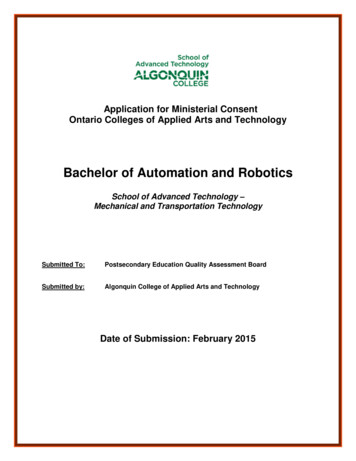
Transcription
Application for Ministerial ConsentOntario Colleges of Applied Arts and TechnologyBachelor of Automation and RoboticsSchool of Advanced Technology –Mechanical and Transportation TechnologySubmitted To:Postsecondary Education Quality Assessment BoardSubmitted by:Algonquin College of Applied Arts and TechnologyDate of Submission: February 2015
Section 1: IntroductionSection 1.1: College and Program InformationFull Legal Name of Organization:Algonquin College of Applied Arts and TechnologyOperating Name of Organization:Algonquin College of Applied Arts and TechnologyCommon Acronym of Organization (if applicable):NAURL for Organization Homepage:www.algonquincollege.comProposed Degree Nomenclature:Bachelor of Automation and RoboticsLocation (specific address) where program is to be delivered (each location requires a locationspecific consent from the Minister):Algonquin College, 1385 Woodroffe Avenue, Ottawa, Ontario K2G 1V8Contact Information, Person Responsible for this Submission:Jo-Ann Aubut, Dean, Academic DevelopmentAlgonquin College1385 Woodroffe AvenueOttawa ON K2G 1V8Tel: 613-727-4723 ext 5581Fax: 613-727-7633Email: aubutj@algonquincollege.comSite Visit Coordinator (if different from above):Jo-Ann Aubut, Dean, Academic DevelopmentAlgonquin College1385 Woodroffe AvenueOttawa ON K2G 1V8Tel: 613-727-4723 ext 5581Fax: 613-727-76332Bachelor of Automation and Robotics
Table of ContentsSection 1: Introduction . 2Section 1.1: College and Program Information . 2Section 1.2: Executive Summary . 6Section 1.3: Program Abstract .13Section 2: Degree Level Summary .14Section 3: Admission, Promotion, and Graduation .19Section 3.1: Admission Requirements for Direct Entry .19Section 3.2: Admission Policies and Procedures for Mature Students .20Section 3.3: Promotion and Graduation Requirements .21Section 3.4: Advanced Standing Policies and Requirements .23Section 4: Program Content .25Section 4.1: Program Advisory Committee .27Section 4.2: Professional Accreditation.41Section 4.3: Learning Outcomes.42Alignment of Program Learning Outcomes with Degree Level Standard.43Mapping of Core and Non-Core Courses to Program Learning Outcomes .55Mapping of Non-Core Courses to Breadth Outcomes .61Section 4.4: Course Descriptions.62Course Descriptions for Core Courses .62Course Descriptions for Non-Core Courses .84Course Descriptions for Non-Core Elective Courses .87Section 4.5: Course Schedules .91Section 4.5.1: Course Schedule 1 .91**Excluded for web version – confidential/proprietary material .91Section 4.5.2: Course Schedule 2 .92Section 4.6: Work-integrated Learning Experience .98Integration of Work Experiences .98Types of Work-integrated Learning Experiences .98Support for Work-integrated Learning Experiences .99Outcomes for Co-op Work Terms .100Student Learning Plan Form – Co-op Term .101Employer Evaluation – Co-op Term .103Conclusion .104Section 4.7: Course Outlines .105**Excluded for web version – confidential/proprietary material .1053Bachelor of Automation and Robotics
Section 4.8: Bridging Course Descriptions .106Section 4.9: Bridging Course Outlines .110**Excluded for web version – confidential/proprietary material .110Section 4.10: Gap Analysis.111Mechanical Engineering Technology (MET) Ontario College Advanced Diploma .111Electrical Engineering Technology (EET) Ontario College Advanced Diploma .118Electro-Mechanical Engineering Technician - Robotics Ontario College Diploma .125Section 5: Program Delivery.130Section 5.1: Quality Assurance of Delivery .131Section 5.2: Student Feedback .134Section 5.3: Web-facilitated, Hybrid, and Online Delivery .136Section 5.3.1: Curriculum Vitae of Online Learning Professional and Technical Staff .142**Excluded for web version – confidential/proprietary material .142Section 6: Capacity to Deliver .143Section 6.1: Learning and Physical Resources .144Section 6.2: Resource Renewal and Upgrading .152Section 6.3: Support Services .153Section 6.4: Faculty .159Section 6.5: Curriculum Vitae Release .162Section 6.6: Curriculum Vitae of Faculty Assigned to the Degree Program .163**Excluded for web version – confidential/proprietary material .163Section 7: Credential Recognition .164Section 8: Regulation and Accreditation .185Section 9: Nomenclature .186Section 10: Program Evaluation .187Section 11: Academic Freedom and Integrity .188Section 12: Student Protection .189Section 13: Economic Need .190OCAS Data on Related Degree Programs (November 2014) .219Applicant Demand – Student Surveys .219Current Employment Opportunities.224Section 14: Duplication .232Section 14.1: Analysis of Similar College Programs .232Section 14.2: Analysis of Similar Ontario University Programs .238Conclusion .2424Bachelor of Automation and Robotics
5Bachelor of Automation and Robotics
Section 1.2: Executive SummaryProposed Credential Nomenclature:Bachelor of Automation and RoboticsAnticipated Program Start Date:September 2016 – Year 1Program OverviewThe field of automation and robotics within engineering is evolving to meet the needs of industry andsociety. The engineering sector continues to see an ever-increasing reliance on automation andautonomous devices, specifically dealing with the evolving specialty of automation and robotics. Theincreased demand for efficiencies and safety has led to a greater need for professionals with suchexpertise.The proposed Bachelor of Automation and Robotics program prepares graduates through acomprehensive theoretical and hands-on approach, balancing logic, science, technology andpracticality. Students begin with the development of a strong base in science and mathematics andcontinue to build on this knowledge within an engineering context. Key skills necessary to succeed inthis field are developed, including problem-solving, critical thinking, communication and managementof information. Through a cohesive and balanced curriculum, students become proficient in workingwith, understanding and practicing engineering methodologies, theories and practices.Work-integrated learning, through cooperative education work terms and practical in-class projects,provide students with opportunities to practice and test theories and methodologies as well as toenhance their knowledge and skills in real-world environments.As well, this comprehensive degree program prepares graduates to pursue further academic study inthe discipline of engineering.Algonquin College will be seeking accreditation for this program from the Canadian EngineeringAccreditation Board. Accreditation of a program is granted only after students have graduated fromthe program. As such, Algonquin will be applying for an accreditation visit in the final year of the firstgraduating class.Program Learning Outcomes1. Analyze, design, modify and support mechanical, software and electrical components,processes and systems by applying fundamentals of engineering.2. Build functional robotic components by researching and integrating knowledge frommechanical, electrical and software engineering practices.3. Customize existing non-autonomous systems into autonomous or semi-autonomous systemsby designing and integrating solutions and developing autonomy algorithms and controls.4. Analyze and solve complex technical problems in the field of robotics and automation byapplying the principles of engineering and mathematics.5. Develop, execute and interpret quantitative and qualitative analysis and tests for industrialmechatronic and automation systems.6. Lead and perform diagnostics on a variety of industrial automation controls, sensors, dataacquisition devices and interfaces by developing and using troubleshooting skills andtechniques.6Bachelor of Automation and Robotics
7. Ensure all work is performed in compliance with relevant laws, codes, regulations, policies,ethical principles, safety procedures and engineering practices and standards.8. Contribute to the on-going and emerging innovation and research in the robotics andautomation field.9. Develop entrepreneurship and effective business planning skills to innovate roboticstechnology targeting new and existing local and global markets.10. Develop personal and professional strategies and plans to adapt to change, maintain currencyand foster interprofessionalism.11. Manage project communications with clients and other professionals to translate abstract ideasinto tangible project requirements and products.12. Identify and apply discipline-specific practices that contribute to the local and global communitythrough social responsibility, economic commitment and environmental stewardship.Curriculum DesignThe curriculum has been designed to meet and exceed the honours degree level standard andprovides the appropriate depth and breadth of knowledge, along with applied specialized preparationin the areas of critical thinking and scholarly research, problem solving and analysis, communications,leadership and professional capacity and autonomy within the field of Automation and Robotics. Thetwo co-op work terms and culminating project courses provide further experiential learningopportunities.The program of study is summarized below:YEARSEMESTERSEMESTER 1YEAR 1SEMESTER 2SEMESTER 3YEAR 2SEMESTER 4COURSE TITLEMAT5801 - Calculus ICST8107 - Introduction to Programming and Problem SolvingMAC8102 - Machine Shop and Manufacturing TechniquesROB8112 - Introduction to RoboticsPHY8103 - Physics IENL1100 - Communications and Academic WritingMAT8202 - Calculus IICAD8202 - Computer Aided DesignCST8203 - Advanced Programming and Data StructuresPHY8203 - Physics IIMAT8203 - Linear AlgebraPHI1000 - Logic and Critical ThinkingPLT1005 - Introduction to OpticsENG8332 - Engineering Mechanics: StaticsELN8304 - Electrical and Electronic Circuits IMAT8406 - Differential Equations and Advanced CalculusSOC2000 - Introduction to SociologyGEO2300 - Principles of Urban PlanningENG8405 - Engineering Mechanics: DynamicsELN8404 - Digital Circuits, Design and MicroprocessorsMAT8400 - Mathematics for EngineersROB8403 - Principles of RoboticsELN8402 - Electrical and Electronic Circuits IIPHI2000 - Introduction to ResearchCo-op Work Term I7Bachelor of Automation and Robotics
SEMESTER 5YEAR 3SEMESTER 6SEMESTER 7YEAR 4SEMESTER 8ENG8603 - Dynamics of MachineryENG8604 - Fluid Mechanics and HydraulicsENG8605 - MechatronicsELN8606 - Control SystemsENG8607 - Mechanics of SolidsENG8608 - Manipulator MechanicsCST8703 - Real Time Systems and Embedded SystemsProgrammingENG8704 - Mechanical Systems DesignROB8705 - Computer Vision for RoboticsENG8706 - Heat Transfer and ThermodynamicsECO8904 - Engineering EconomicsROB8707 - Mobile Robotics: Systems and DesignPHI2002 - Ethical Decision MakingCo-op Work Term IIROB8902 - Mobile Robotics: Navigation and ControlROB8903 - Robotics and Automation Project IMGT6120 - EntrepreneurshipENG8905 - Sensors and InstrumentationElectiveElectiveROB9102 - Advanced Mechatronics and Multi-Robot SystemsENG9103 - System Level ReliabilityROB9104 - Robotics and Automation Project IIElectiveElectiveAlgonquin College’s Strengths and Capacity to Deliver the ProgramAlgonquin College of Applied Arts and Technology was established in 1967 and was named after theFirst Nations people who lived in the area. Algonquin was formed from the merger of the EasternOntario Institute of Technology, established in 1957, and the Ontario Vocational Centre, establishedin 1965. The College has undergone significant growth since its establishment and continues to growtoday.Dedication to student success is one of Algonquin College's primary guiding principles and isdemonstrated in the quality of its programs, its staff, the continual expansion of its facilities, and byits forging of strategic partnerships. Furthermore, the College strives to ensure students have accessto the education and skills training demanded by the marketplace to launch rewarding careers intheir chosen fields.With thousands of successful alumni, an annual full-time enrolment of approximately 18,000students, 40,000 part-time registrations and thousands of full-time and part-time employees,Algonquin makes a significant economic and social impact locally, regionally, nationally andinternationally.8Bachelor of Automation and Robotics
Algonquin is committed to being one of the most comprehensive colleges in Ontario, offering a broadvariety of programs, subject matter, delivery modes and program durations. Algonquin is also theonly publicly-funded English-language College in Ottawa, Perth and Pembroke and services theneeds of these areas and their surrounding communities. As a result, Algonquin will continue toexpand its offerings which include a full range of programs including academic upgrading,apprenticeship, certificate, graduate certificate, diploma, advanced diploma and degree programs aswell as corporate learning solutions and international education and projects. As the province‘slabour needs evolve, so will the program mix of the College. Algonquin‘s application for MinisterialConsent to offer a Bachelor of Automation and Robotics program is in response to the evolvinglabour needs of the engineering field. This application further aligns with the College‘s presentdirection detailed within its current Strategic Plan 2012-2017,1 that recognizes the need to offer asuite of programs and articulates the intent to enroll more students in degree program offerings.Furthermore, the program aligns with the Strategic Mandate Agreement in that ‘Engineering,Technology and Trades’ is an identified area of strength and proposed area of new program growth.Robotics and Automation is a new and emerging field with continuous and rapid innovation. TheInstitute of Electrical and Electronics Engineers (IEEE) Robotics and Automation Society wasfounded in 1984 and in 2004, IEEE dedicated a transactions journal to Robotics and Automationseparate from its traditional transactions journals. An additional IEEE conference on IntelligentRobots and Systems is hosted every year attracting hundreds of students, faculty and individualsfrom industry. While a relatively new and emerging field, it is growing rapidly in the face of evolvingindustry need for increased automation and robotics.Currently, Algonquin offers diploma programs related to the area of study focused within theproposed Bachelor of Automation and Robotics. The College has established a solid reputation inthe delivery of high quality advanced technology and engineering programming and currently offersone related diploma program in Electro-Mechanical Engineering Technician and two advanceddiploma programs in Mechanical Engineering Technology and Electrical Engineering Technologythrough a variety of delivery modes.Algonquin College’s Woodroffe campus provides students with access to existing practical labenvironments, as well as through the introduction of the proposed program, additional newlaboratory space that will be designed to support the student’s learning experience. This will providestudents with an exceptional teaching environment to engage in practical learning opportunities. TheCollege‘s capacity to provide the human and physical resources required to offer an excellenteducational experience for students is unsurpassed in the region. In addition, the College‘s ability todeliver bachelor-level education is evidenced by the present delivery of four existing degreeprograms as well as four collaborative degrees with local universities.This application details the rationale for offering the Bachelor of Automation and Robotics, theprogram of study to be undertaken and Algonquin College’s capacity to deliver this program with theavailability of facilities, learning resources, and the technological infrastructure used to supportlearning. Additionally, the majority of faculty associated with the development and proposed teachingof the program have the required terminal credentials in their respective fields.1Strategic Plan 2012-2017, June 11, trategic Plan 12 17.pdf, p.169Bachelor of Automation and Robotics
Opportunities for Graduates and Overview of Support and Recognition of the Program fromthe Profession and Other Postsecondary InstitutionsDuring the course of developing the Bachelor of Automation and Robotics program proposal, an indepth labour market analysis was commissioned by the College to determine the need for theproposed program. The study concluded that there is a definite need for the degree program andthat the credential will provide graduates with opportunities for advancement in the engineering field,a field that encompasses both automation and robotics.Labour Market AnalysisIn the summer of 2012, the College contracted Hanover Research to examine the potential need fora Bachelor‘s degree in the field of Robotics and Engineering. The following highlights key findingsexcerpted from the full study, provided in Section 13, which provides evidence of labour marketdemand:High-tech manufacturing requires the work of a skilled and highly trained labour force to design,build, and maintain automated and robotic equipment. Individuals must be knowledgeable in thefields of mechanical, electronic, and computer engineering in order to advance in the field ofautomation and robotics. Highly skilled engineers with a strong interdisciplinary background are inshort supply and demand is high, especially in geographic areas that are high-tech manufacturinghubs.While demand for skilled engineers is high, no Canadian institutions currently offer a Bachelor ofAutomation and Robotics degree. The most similar degree is the Bachelor of Engineering inMechatronics Engineering, which is offered by McMaster University, Simon Fraser University, andthe University of Waterloo. Mechatronics engineering is an interdisciplinary approach to engineeringthat incorporates elements of mechanical, electrical, and computer engineering, with a focus onintelligent systems. Considering Algonquin College’s proposed Bachelor of Automation and Roboticsto differ primarily in name from a mechatronics engineering program, this report focuses primarily onthe latter.The research conducted for this report yielded the following key findings: Ontario is the best market in Canada for mechanical and electrical engineering degrees interms of both enrollments and completions. Given its strength in similar engineeringfields, it is most likely that Ontario is the strongest market in Canada for mechatronicsengineering undergraduate degree programs.The projected labour market for engineers in general in Canada is relatively balanced. Supplyexceeds demand, according to projections for the period 2011-2020, though achieving thisbalance is dependent on immigration to an extent. Considering school leavers alone, thesupply of workers will be insufficient to meet engineering job demand through 2020.Work experience, both in terms of laboratory work and employment experience, is acrucial consideration in the hiring of mechatronics engineers. According to one industryexecutive, candidates with three to five years of relevant working experience are rare, andcompetition for experienced mechatronics engineers is fierce. Companies are willing, thoughnot necessarily enthusiastic, to take on and train new graduates of mechatronics ormechanical engineering programs. For recent graduates, relevant laboratory experience andstrong internship or co-op experience are essential to proving their credentials to potentialemployers.10Bachelor of Automation and Robotics
While it is possible for students to graduate with mechatronics engineering degrees orspecializations within four years, most undergraduate mechatronics engineeringprograms in Canada take more than four years to complete. Given the industry demandfor work experience, a five-year degree with a co-op experience may be more desirable toemployers than a four-year degree.Keys to success in establishing a successful mechatronics program are forging partnershipswith potential employers of graduates, creating and maintaining a teaching-centeredlaboratory, and acquiring and training an interdisciplinary faculty in the fields of electrical,mechanical, and computer engineering.o Partnerships with local businesses provide cooperative education (co-op)opportunities for students to gain practical experience in their field prior to graduation.o Every faculty member and business representative interviewed for this reportunanimously agreed that a functional, teaching-centered laboratory that givesstudents practical experience is of the utmost importance. Furthermore, students andfaculty must be trained and able to use available equipment to its maximum potential.o Finally, a mechatronics program must have an interdisciplinary faculty drawing onexpertise from the fields of mechanical, electrical, and computer engineering.Employer Demand InterestInterest in a degree program that would allow individuals direct entry into year one or to bridge intoyear two or three, depending on their credentials, has been strong within the community in Ottawa.The Bachelor of Automation and Robotics Program Advisory Committee is supportive and agree withthe existing employer demand. The field of automation and robotics is a new and emerging area ofstudy within engineering, providing unique and innovative opportunities for employers.The Hanover Research study also provides references to indicators of employer interest anddemand here extracted: The Canadian Occupational Projections System (COPS) only provides employmentprojections for broad occupational categories, with the relevant targets for this report being“Civil, Mechanical, Electrical, and Chemical Engineers” and “Other Engineers.” Asshown in Figure 3.1, both categories are projected to experience a steady increase intotal employment level across the 2011-2020 timeframe. In both broad occupational categories, the total number of job seekers will exceed thetotal number of job openings—71,768 job seekers for 60,436 jobs as Civil, Mechanical,Electrical, and Chemical Engineers, and 37,851 job seekers for 36,655 jobs as OtherEngineers. However, it should be noted that the total number of job seekers only exceedsthe number of job openings due to immigration and other sources of qualifiedworkers; if only Canadian school leavers are considered, the number of preparedworkers actually falls short of the number of projected job openings. For example, overthe period 2011-2020, the COPS projections estimate a total of 51,380 school leaversqualified for work as Civil, Mechanical, Electrical, and Chemical Engineers, a numberinsufficient to meet projected job demand.The Advisory Committee, as well as numerous other sector representatives, has endorsed theproposed degree. This application includes recent letters of support from prominent associations andsector affiliates, including the ABB Robotics Inc., Misumi USA Inc., Siemens (Siemens CanadaLimited), JDSU, Neptec Design Group, Royal Canadian Mint, Clearpath Robotics, MPB11Bachelor of Automation and Robotics
Communciations Inc., Gaitronics, Electromate, Avidbots Corp., Kinova Robotics, Epocal, FamicTechnologies Inc., Axium Inc., ING Robotic Aviation. Endorsements by the aforementioned sectoraffiliates provide testament to Algonquin‘s capacity to deliver quality programming in the field ofautomation and robotics.12Bachelor of Automation and Robotics
Applicant Demand InterestAs noted within the labour market analysis, the proposed program provides a unique combination ofknowledge and skills that is not easily comparable to other offerings. There are, however, two relatedcollege degree programs that exist, Conestoga’s Bachelor of Engineering – Electronic SystemsEngineering and their Bachelor of Engineering – Mechanical Systems Engineering that can be usedto assess the potential demand for this degree. The data provided in Section 13 was obtained fromthe Ontario College Application Service and indicates existing demand for comparable programs atother colleges. Additionally, the College undertook a survey of students in the MechanicalEngineering Technology Advanced Diploma program. Student interest was high, with approximately66% of students (107 out of 163 students surveyed) indicating some level of interest in the proposeddegree program.The addition of the Bachelor of Automation and Robotics to the College‘s existing programmingwould expand the educational opportunities for further academic study and lifelong learning.Graduates of the Bachelor of Automation and Robotics program may receive consideration foradmission to select graduate programs. Evidence of this is included in Section 13.In summary, data from the labour market analysis, student surveys, and sector employers, alongwith trends within the field of engineering affirm the need for a Bachelor of Automation and Roboticsdegree program. There is strong support from community stakeholders
The field of automation and robotics within engineering is evolving to meet the needs of industry and society. The engineering sector continues to see an ever-increasing reliance on automation and autonomous devic

